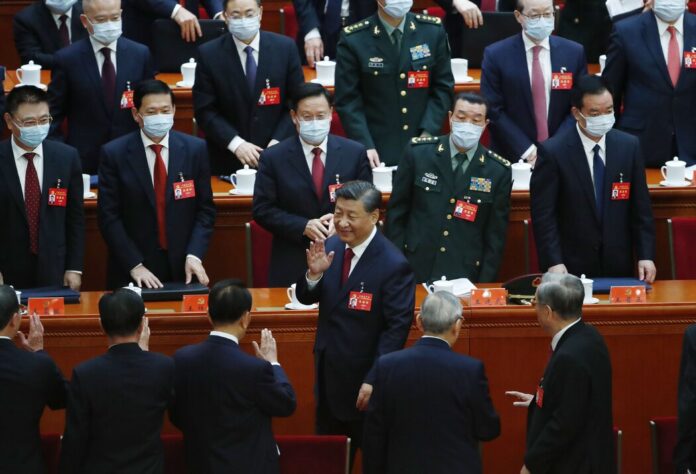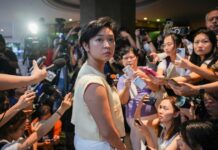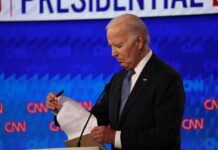Xi’s totalitarian rule is steering China towards revolutionary upheavals
Editorial from Socialist (社會主義者) magazine, published by International Socialist Alternative in China, Hong Kong and Taiwan
The Chinese regime (CCP) is holding its 20th Congress in Beijing, at which Xi Jinping will be confirmed as dictator-for-life. An unlimited non-stop state propaganda campaign has been eulogizing the “many achievements” of Xi’s decade-long reign. But in reality Xi’s tenure has been a succession of unmitigated disasters that ultimately threaten revolution and the end of the CCP’s grip on power.
Chief among these is the collapse in economic growth, a reality that is masked by increasing amounts of fake or manipulated GDP data. Others include Xi’s paralysing zero-Covid policy, major foreign policy blunders over Ukraine and the Belt and Road Initiative, a bogus “victory” in Hong Kong that has cost the CCP hugely, not least in Taiwan, and most of all surrendering the initiative to US imperialism in the new Cold War.
The 20th Congress is more akin to a coronation ceremony than a political meeting. The details of the impending reshuffle of the party-state’s leading organs such as the Politburo and its Standing Committee (PSC) are a closely guarded secret. These changes will be announced on the final day of the congress, although they have already been decided through a process of factional infighting and trade-offs.
Xi may have been forced to make some concessions to his opponents in order to secure his main objective: an extension and consolidation of his unprecedented personal dictatorship. We must wait a few more days to learn more. The new PSC line-up will then be scrutinised to see the extent of any concessions, which in turn will be a measure of how firmly Xi sits on the throne as he begins his historic third term.
Systemic breakdown
But whatever the formal outcome of the 20th Congress, the next instalment of Xi’s rule, up to the 21st Congress in 2027, will be completely dominated by a social and political crisis of historic proportions. The CCP’s state capitalist economic model is facing systemic breakdown. This is especially with the implosion of the property sector, which for almost two decades has been China’s main locomotive of economic growth accounting for 30 percent of GDP.
Xi’s manic implementation of a zero-Covid policy, with around 20 percent of China’s population currently in some form of lockdown, has stoked an unprecedented backlash. The latest example was an audacious “flash” protest in central Beijing just days before the congress opened, with slogans calling for Xi to be removed (see statement below).
The demographic crisis, which is also a crucial ingredient in the property sector crisis because almost half of China’s cities are not growing or are actually shrinking, means that India will next year strip China of its mantle of “most populous nation”. That fact alone is a blow to the CCP’s imperialist superpower ambitions. It is an additional setback for China’s economy with massive implications for the imperialist Cold War against the US.
Economically, on the basis of capitalism even of the “state capitalist” variety, a shrinking population means fewer workers (the size of China’s labour force peaked in 2012), fewer consumers, and a growing proportion of pensioners (very poor pensioners by international comparisons).
The CCP’s brutal one-child policy of 1980-2016 bears much of the blame for this, but even after that policy was relaxed China’s birth rate has continued to drop. Capitalism has priced children out of the market. Studies by Chinese think-tank YuWa Population show the cost of raising a child in China is nearly seven times per capita GDP, compared with four times in the US. Since Xi came to power in 2012, the number of births per year has fallen by a jaw-dropping 45 percent. And now Xi’s zero-Covid policy is making would-be parents even more reluctant to have children.
Japan’s population also began to decline just a few years before its property sector crashed in the 1990s. While this is not the sole cause of the crash – the main cause in Japan and China is the bursting of financial bubbles based upon extreme levels of overproduction – China is now experiencing a similar combination of factors only on a much bigger scale than in Japan.
Cold War reverses
The economic crisis is hobbling the CCP’s grand plan to supplant US imperialism as the top global economy and superpower. The NPC’s March target of 5.5 percent GDP growth for this year is no longer talked about, because nobody – probably not even Xi – believes it is realistic. Most forecasters have downgraded their China outlook to 3 percent or lower (the World Bank last month predicted 2.8 percent growth, down from 5 percent it predicted in April). But in reality, zero is a more realistic prognosis.
More importantly, 2022 looks set to break the trend of China gradually closing the gap with the US economy. Potentially, this has huge implications and invalidates Xi’s mantra: “the East is rising, the West is in decline”. According to former World Bank China chief Bert Hofman: “This year will see a reversal of China’s catch-up with the United States in US dollar terms. Due to low real growth in China, modest inflation and sharp depreciation of the yuan, the gap between China’s and the US’s GDP will jump from US$5.3 trillion in 2021 to an estimated $8.3 trillion.”
Xi who has gathered all the levers of power into his own hands cannot shift the blame elsewhere. Zero-Covid has been an economic disaster of course, but most of all it’s the regime’s culpability in allowing the property bubble to inflate year after year, leading to its inevitable implosion. CCP policies created the bubble because debt-driven property investment was its default position to support GDP growth, especially under adverse conditions such as the 2008 financial crisis and again in 2020.
Tech war on an “incredible scale”
In the shadow of the Ukraine war, the US has massively stepped up its Cold War agenda against China. The latest example is the draconian new export controls imposed last week that block the sale to China of advanced computer chips and the tools to make such chips. The measures from the US Commerce Department apply not only to US companies but also to foreign companies if their products contain US-made components or software.
The latest measures follow a raft of tech-related policies from Biden’s government such as the CHIPS Act, which allocates over US$50 billion for homegrown research and production of semiconductors as a way to expel China from global tech supply chains.
The latest US restrictions clearly target China’s military programs, to prevent it developing weapons systems that can match those of the US. It is a thinly disguised act of war “by other means” in other words.
“In weaponizing its dominant choke-point positions in the global semiconductor value chain, the United States is exercising technological and geopolitical power on an incredible scale,” declared former Defense Department official Gregory C. Allen.
Significantly, the new chip restrictions are modelled on sanctions imposed on Russia after its invasion of Ukraine in February. This underlines how US imperialism, at the head of a re-consolidated western capitalist bloc, has exploited Russia’s ill-fated military adventure to conduct a proxy struggle in the larger long-term conflict with China. This dynamic is something ISA has explained since the start of the Ukraine war.
Jake Sullivan, Biden’s national security adviser, referred in a recent speech to the Russian tech sanctions saying these had forced “Russia to use chips from dishwashers in its military equipment.” Sullivan continued, “This has demonstrated that technology export controls can be more than just a preventative tool. If implemented in a way that is robust, durable, and comprehensive, they can be a new strategic asset in the US and allied toolkit to impose costs on adversaries, and even over time degrade their battlefield capabilities.”
The Biden administration’s escalation of the tech war will inevitably bring forth countermeasures from Xi’s regime. There are also significant risks of blowback from these restrictions, harming key sectors of the US economy (China is the final market for around 25 percent of global chip production). The export controls could also lead to new strains within the US-led western camp.
No way out
The escalation of the imperialist Cold War, which is also the main driver of economic deglobalization, imposes additional pain on China’s economy. Xi Jinping appears to be in denial on this score too, just as he has been over the chaos and unpopularity of zero-Covid and over the scale of the property collapse.
Xi emphasizes self-reliance and building up domestic consumption (“dual circulation”), in a nod to Mao Zedong. But there is a vast difference between China’s capitalist economy today, the world’s second biggest, and the largely closed and much poorer China of the 1960s, which operated as a primitive and very bureaucratic planned economy.
Recent economic trends do not offer much encouragement for Xi’s “dual circulation” schema. Mass unemployment and wage cuts now affect wide layers of the population, with one-in-five young people unemployed, more than double the rate in the United States. Starting salaries for graduates who managed to get jobs this summer are on average 12 percent lower than a year ago. Official data shows job vacancies in the second quarter were down 19 percent from a year earlier while job applications were up 135 percent. It’s hardly surprising that young people are the demographic most disenchanted with CCP rule.
China is now in the second year of its property sector slump, which Xi’s regime has been powerless to stem. This year the crisis has spread to local governments, the main drivers of investment in China’s state capitalist system. Most provinces and cities carry unsustainable debt loads as the bills mount up after years of wasteful “white elephant” infrastructure projects that were built to inflate GDP figures.
This year they are being forced to make huge budget cuts, including wage cuts of 30 to 40 percent for some government employees. Local governments have been hammered by the 31.4 percent drop in land sales compared to 2021, an inevitable result of the collapsing property market.
Land sales to property developers have been the single biggest source of local government revenue for more than a decade. Data from the Ministry of Finance shows the combined budget shortfall for all levels of government in the first half of this year was 5.1 trillion yuan (US$758 billion) compared to 718 billion yuan at the same point in 2021, an increase of 600 percent.
The economic crisis is fuelling unprecedented levels of social and political discontent. The shock effect cannot be overstated in a society that has in general since the 1980s only experienced rapid economic growth until the abrupt slowdown of recent years.
Not surprisingly, the full scale of today’s economic crisis is being suppressed by state media. But it is hugely underestimated even by global capitalism. Most overseas economic analysis focuses on the self-inflicted pain of Xi’s zero-Covid policy, seeing this as the main cause of China’s economic ills. These commentators believe, mistakenly in our opinion, that when zero-Covid is eventually lifted (and most signals indicate that will not be any time soon), this will unleash a powerful economic rebound. But, while paralyzing lockdowns and disruption have aggravated China’s economic situation, the crisis has deeper causes.
The bubble has burst
If the Covid-19 pandemic was a once-in-a-century event that first broke out in Wuhan, and was criminally mishandled by Xi’s acolytes in the first crucial weeks, then the bursting of China’s property bubble is its economic equivalent. Its impact will leave no part of the global capitalist economy untouched.
Due to its exceptional scale – twice the size of the US property market by value – and the extent of overinvestment, overconstruction and overspeculation in China, there has never been a collapsed investment bubble that comes close to this. “The Chinese property bubble is not just any property bubble – it is the largest single phase of accumulation of wealth in economic history,” said the economic historian Adam Tooze (The Guardian, 23 September).
At the CCP’s 19th Congress in 2017, Xi delivered a speech saying houses “are for living in not for speculation”. The paramount leader stating the obvious in this way gave a hint of how massively the world’s biggest housing market has been hi-jacked by financial speculators, among them a large cohort of CCP officials.
The Economist (12 September) pointed out that 70 percent of all houses sold since 2018 (an incredible 50 million units) were sold to people who already owned a home. Clearly, despite his official but inaccurate status as the “most powerful leader” since Mao, Xi has been powerless to prevent this speculation, which failed to get homes to those who need them and has now crashed the whole economy.
The collapse of the housing bubble, which chinaworker.info and ISA predicted, has begun to suck down other gigantic sectors like steel and cement – also far and away the biggest in the world. Almost one-in-three Chinese steel companies could go bankrupt according to Li Ganpo, chairman of Hebei Jingye Steel Group. It is a similar story with cement. Global cement output is down 8 percent in the first six months of 2022, the biggest fall in 20 years. The main cause is a 15 percent drop in China’s cement output.
Most seriously, the next link in the chain of crisis could be the banking sector. The precarious state of local governments, charged by Beijing with bailing out the collapsed property market, means they themselves will almost certainly need a bailout in the next period. From a financial crisis in China’s local governments there is only a short distance to a banking crisis.
Totalitarian rule
Under Xi, China has become ultra-repressive as Hong Kong and especially Xinjiang testify. The dictatorship bans all independent political activity, but even top CCP leaders, especially potential rivals to Xi, are constantly monitored by the CCP’s security agencies and warned not to criticise Xi’s policies.
In September, two senior former officials Sun Lijiun and Fu Zhenghua were sentenced to death, to be commuted to life imprisonment, following corruption trials that were clearly staged as a warning to Xi’s factional opponents not to take their opposition too far. Sun amassed a fortune from bribes but also stands accused of building an anti-Xi “political clique”. He was a vice minister of public security and his ally Fu was Justice Minister. The police chiefs of three major regions, Shanghai, Chongqing, and Shanxi, were also each sentenced to more than a decade in prison, accused of being part of the same oppositional “clique” as Sun and Fu.
The 20th Congress may enshrine Xi’s rambling pseudo-ideology in the CCP’s constitution as “Xi Jinping Thought”. Only Mao, of all China’s previous autocrats, enjoys a similar distinction. Xi’s “theory” was enshrined into the constitution five years ago, but under the less catchy moniker “Xi Jinping Thought on Socialism with Chinese Characteristics in a New Era.” The abbreviated version would confer a higher status on a par with “Mao Zedong Thought”. In a parallel development, Xi may also be anointed “lingxiu”, which means “people’s leader”. Again, the rationale behind such rituals is to suggest historical parity with Mao.
As the economy crashes and millions are locked down in their homes, the main focus of the “most powerful leader” is to aurify his official titles. The symbolism plays a role, for the reason that ten years into his rule Xi is still engaged in a fierce power struggle against rival CCP factions and “cliques”. An increased level of conflict between Beijing and regional CCP elites as a consequence of the economic crisis will sharpen the power struggle in coming years. Xi still feels the need to raise himself further above the state and society, Bonapartist style, in order to subdue resistance.
The size of the new Politburo Standing Committee will offer clues over the extent to which compromises have been forced upon Xi. If the current seven-man PSC is widened to nine, that could suggest Xi has been forced to concede places to opposition factions and needs a bigger body to include his own appointees. A smaller body of five seats, as mooted in some media reports, would conversely suggest Xi’s position has been strengthened.
An important question will be who takes over from Li Keqiang, now the most recognised anti-Xi figure, as China’s next premier. Wang Yang and especially Hu Chunhua are associated with Li’s tuanpai faction, and should one of them become premier this would indicate a concession from Xi.
The anti-Xi layers, who are not strong but enjoy backing from sections of the capitalist class, the princelings, and international capital, would hope to use the premier’s position as a check on Xi, an attempt to pressure him over economic policy in particular. In a few days’ time we will know. Whatever the outcome it will not fundamentally change the perspectives for the CCP regime, which is heading into the greatest of all storms.
“New Tank Man” protest gets huge response
The following is a statement issued by chinaworker.info.
Three days before the CCP’s 20th Congress, huge banners were displayed on the Sitong bridge in the central Haidian district of Beijing, including a call for a “strike against the dictator and national traitor Xi Jinping”. After hanging the banners, the demonstrators burned tyres and repeatedly broadcast slogans over loudspeakers, attracting the attention of many people passing by and taking photographs. The news was swiftly purged from the domestic media and internet, with over 1.4 million user accounts reportedly permanently cancelled as a result.




